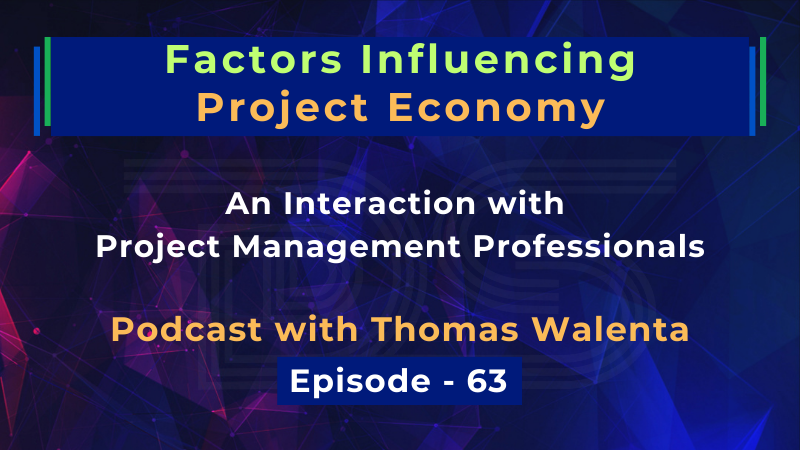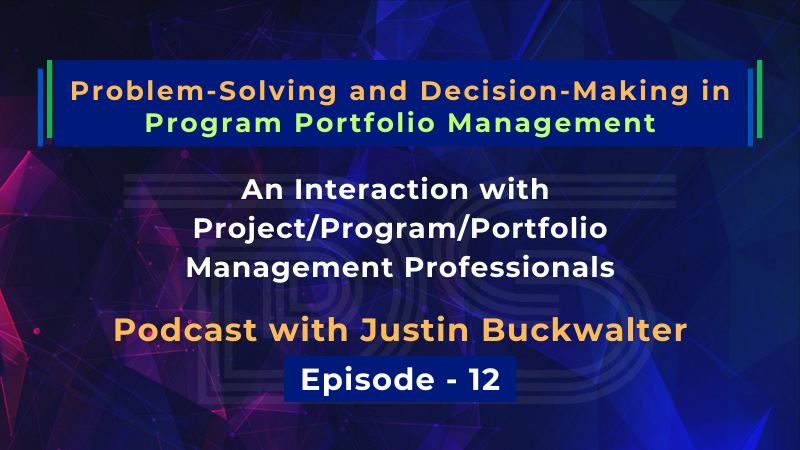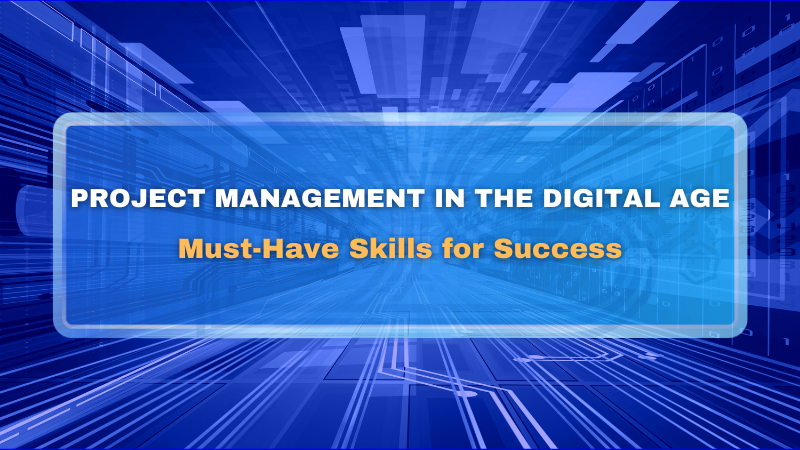
by DharamCW | May 1, 2024 | Program Management
Factors Influencing Project Economy | Navigating the Complexities of the Project Economy
In this insightful episode, join Thomas Walenta and me as we delve into the evolving dynamics of the project economy. Here’s what you’ll discover:
+ Demographic Shifts: Strategies for project managers to adapt to changing demographics effectively.
+ Climate Resilience: Integrating climate change considerations into your project planning.
+ Technological Advancements: Embracing AI and its transformative impact on projects.
+ Globalization Effects: Managing remote teams and cultural diversity in projects.
+ Geopolitical Tensions: Navigating the complexities of global trade and political challenges.
These discussions are brimming with practical insights designed to empower project leaders like you to navigate these challenges with confidence and strategic acumen.
🚀 Embrace the chance to Advance Your Project Management Career:
– Register for my upcoming PgMP/PfMP Success Story Webinar: https://bit.ly/3TSx8fj
– Book an obligation-free consultation session on Project management Career, training, and certifications. Get personalized advice and guidance tailored to your career goals: http://talktodharam.com
– Discover training offers and certification discounts: https://bit.ly/3jWVepD
– Stay updated with our Q&A series and certification success stories by subscribing to the vCare Project Management YouTube channel at https://bit.ly/2YF0wJl
– Follow my podcasts and interviews with Project Management Experts on YouTube at https://bit.ly/2NDY8wd

by admin | Apr 28, 2024 | Agile and Scrum Practices
🌟 Boost Your Agile Team’s Emotional Intelligence! 🌟
In our latest discussion on Agile and Emotional Intelligence, Justin Buckwalter, PfMP, PgMP, PMP, PMI-ACP, PMI-RMP and I uncover the pivotal role of EI in team success. In the rapidly evolving project environment, Emotional intelligence (EI) is not just a bonus—it’s essential. 🚀
🔍 Episode Highlights:
+ Understanding EI: Discover why Emotional Intelligence is crucial for team collaboration and effective decision-making.
+ Agile & EI Synergy: Learn how to apply Agile practices to boost EI in your teams.
+ Navigating Challenges: Explore strategies to overcome potential conflicts when integrating EI into team dynamics.
+ Emotional Agility: Enhance workplace and personal relationships through improved communication and understanding.
+ Leadership Through EI: Empower project managers to harness EI for better leadership and more productive teams.
🎧 Tune into our conversation and gain invaluable insights on enhancing your team’s emotional capabilities! Check out the episode now: https://youtu.be/SQQZFcz7Ng4
💬 Share your thoughts on Emotional Intelligence vs. Emotional Agility in our project environments. What challenges have you faced integrating EI into your projects?
🚀 Elevate Your Project Management Career:
– Register for my upcoming PgMP/PfMP Success Story Webinar: https://bit.ly/3TSx8fj
– Book an obligation-free consultation session on Project management Career, training, and certifications: http://talktodharam.com
– Discover training offers and certification discounts: https://bit.ly/3jWVepD
– Stay updated with our Q&A series and certification success stories by subscribing to the vCare Project Management YouTube channel at https://bit.ly/2YF0wJl
– Follow my podcasts and interviews with Project Management Experts on YouTube at https://bit.ly/2NDY8wd

by admin | Apr 10, 2024 | Project Management
Join Thomas Walenta, a renowned Global Project Economy expert, and myself in Episode 62 as we delve into the transformative world of projectification. We’ll unravel how the evolution towards a “project society” reshapes industries. This episode explores the ripple effects of projectification on innovation, digital progression, and the global market landscape. We’ll discuss the dynamic shift towards more agile and flexible work arrangements, the dual-edged sword they present, and the broader societal impacts that extend far beyond project completion.
Engage with us as we challenge the traditional “Business as Usual” model and dissect the evolving roles of PMOs in stable and dynamic organizational contexts. This insightful dialogue, where we share unique perspectives on the topic, is not just about information but sparking thought and discussion on how projectification influences businesses and society.
Don’t miss out on this crucial discussion that is shaping the future of work and societal development. It’s a conversation you need to be a part of. Watch now: https://youtu.be/7IXgqFQc23w
🚀 Seize the opportunity to Elevate Your Project Management Career:
– Register for my upcoming PgMP/PfMP Success Story Webinar: https://bit.ly/4bzs0U6
– Book an obligation-free consultation session on Project management Career, training, and certifications: http://talktodharam.com
– Discover training offers and certification discounts: https://bit.ly/3jWVepD
– Stay updated with our Q&A series and certification success stories by subscribing to the vCare Project Management YouTube channel at https://bit.ly/2YF0wJl
– Follow my podcasts and interviews with Project Management Experts on YouTube at https://bit.ly/2NDY8wd

by DharamCW | Feb 19, 2024 | Program Management
Problem-Solving and Decision-Making in Program Portfolio Management | Justin Buckwalter | Episode 12
In a world where uncertainty is the only certainty, Problem Solving and Decision Making have never been more crucial for Program Management and Portfolio Management professionals. Join me for a stimulating discussion with Justin Buckwalter, PfMP, PgMP, PMP, PMI-ACP, PMI-RMP on Episode 12 of our series, exploring the frontiers of decision-making in the VUCA environment.
🔍 Episode Highlights:
– Does the adage ‘Too many cooks spoil the broth’ hold in project decision-making? We invite you to weigh in with your experiences.
– Uncover how Artificial Intelligence is reshaping our approach as Problem Solvers in the realm of program/portfolio management.
– Dive into strategies for navigating through economic uncertainty and making swift project decisions.
– Discuss overcoming behavioral biases and harnessing the power of Change Management and Risk Mitigation in sensitive projects.
👨💼 As Project Leaders, we must evolve, adapt, and often recover from decision-making mishaps. How do you pivot and keep the momentum going?
For a deep dive into these critical competencies that define the success of modern program/portfolio managers, tune into our conversation.
🚀 Elevate Your Project Management Career:
– Register for my upcoming PgMP/PfMP Success Story Webinar: https://bit.ly/3S53K3a
– Book an obligation-free consultation session on Project management Career, training, and certifications: http://talktodharam.com/
– Discover training offers and certification discounts: https://bit.ly/3jWVepD
– Stay updated with our Q&A series and certification success stories by subscribing to the vCare Project Management YouTube channel at https://bit.ly/2YF0wJl
– Follow my podcasts and interviews with Project Management Experts on YouTube at https://bit.ly/2NDY8wd

by DharamCW | Feb 11, 2024 | Project Management
Project Management in the Digital Age: Must-Have Skills for Success
Digital Mastery: The New Frontier for Project Managers
In the ever-evolving landscape of project management, embracing digital skills is no longer optional—it’s imperative. Let me try to guide you through some digital competencies that are now critical in the project management arena.

Digital Skills for Project Managers
1️⃣ Data Science Prowess: Unlock project potential with data analytics, transforming raw numbers into actionable insights.

Data Science Skills
2️⃣ Innovative Mindset: Cultivate creativity to drive breakthroughs in project execution, proving that innovation is the new currency in our field.

Innovative Mindset
3️⃣ Security & Privacy Acumen: Safeguard sensitive information, ensuring that every digital footprint meets stringent security protocols.

Security & Privacy Knowledge
4️⃣ Regulatory Compliance Know-how: Bridge the gaps between diverse teams, guaranteeing legal and regulatory harmony across project lifecycles.

Legal and Regulatory Compliance Knowledge
5️⃣ Data-Driven Decision Making: Harness the power of data to steer strategic decisions, elevating projects with precision and foresight.

Ability to Make Data-Driven Decision
6️⃣ Collaborative Leadership: Foster unity in remote and diverse teams, employing cutting-edge tools to amplify collective efficiency.

Collaborative Leadership Skills
Mastering these skills doesn’t just prepare you for the future—it catapults you there.
Embrace the digital revolution and elevate your project management game to new heights. Let’s transform challenges into opportunities with the right digital toolkit.
Follow Me On,
Linkedin – https://bit.ly/3jJ0zeS
Facebook – https://bit.ly/3jQRTmV
Instagram – https://bit.ly/3h6xzMB
Twitter – http://bit.ly/3zB4Qv0
Pinterest – http://bit.ly/40H4Fdu
YouTube – https://bit.ly/2NDY8wd

Follow Me On Social Medias
🚀 Elevate Your Project Management Career:
– Register for my upcoming PgMP/PfMP Success Story Webinar: https://bit.ly/3S53K3a
– Book an obligation-free consultation session on Project management Career, training, and certifications: http://bit.ly/2SbhTOK
– Discover training offers and certification discounts: https://bit.ly/3jWVepD
– Stay updated with our Q&A series and certification success stories by subscribing to the vCare Project Management YouTube channel at https://bit.ly/2YF0wJl
– Follow my podcasts and interviews with Project Management Experts on YouTube at https://bit.ly/2NDY8wd


















Recent Comments